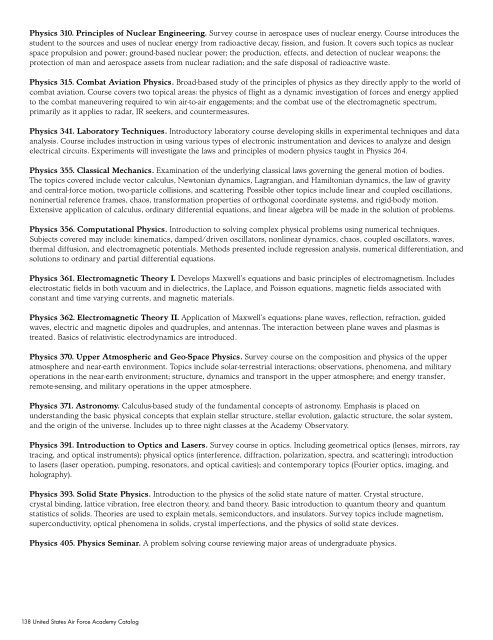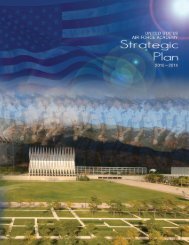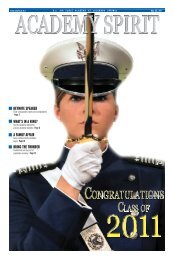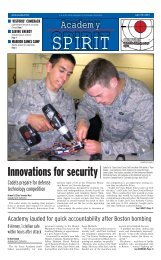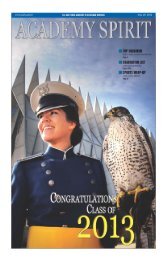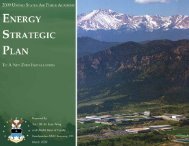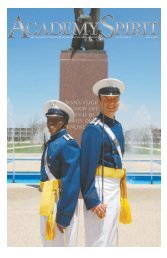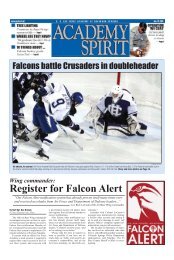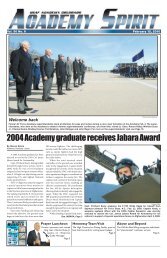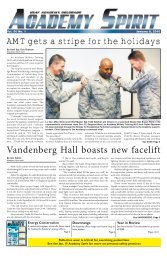2008-2009 Catalog - United States Air Force Academy
2008-2009 Catalog - United States Air Force Academy
2008-2009 Catalog - United States Air Force Academy
Create successful ePaper yourself
Turn your PDF publications into a flip-book with our unique Google optimized e-Paper software.
Physics 310. Principles of Nuclear Engineering. Survey course in aerospace uses of nuclear energy. Course introduces the<br />
student to the sources and uses of nuclear energy from radioactive decay, fission, and fusion. It covers such topics as nuclear<br />
space propulsion and power; ground-based nuclear power; the production, effects, and detection of nuclear weapons; the<br />
protection of man and aerospace assets from nuclear radiation; and the safe disposal of radioactive waste.<br />
Physics 315. Combat Aviation Physics. Broad-based study of the principles of physics as they directly apply to the world of<br />
combat aviation. Course covers two topical areas: the physics of flight as a dynamic investigation of forces and energy applied<br />
to the combat maneuvering required to win air-to-air engagements; and the combat use of the electromagnetic spectrum,<br />
primarily as it applies to radar, IR seekers, and countermeasures.<br />
Physics 341. Laboratory Techniques. Introductory laboratory course developing skills in experimental techniques and data<br />
analysis. Course includes instruction in using various types of electronic instrumentation and devices to analyze and design<br />
electrical circuits. Experiments will investigate the laws and principles of modern physics taught in Physics 264.<br />
Physics 355. Classical Mechanics. Examination of the underlying classical laws governing the general motion of bodies.<br />
The topics covered include vector calculus, Newtonian dynamics, Lagrangian, and Hamiltonian dynamics, the law of gravity<br />
and central-force motion, two-particle collisions, and scattering. Possible other topics include linear and coupled oscillations,<br />
noninertial reference frames, chaos, transformation properties of orthogonal coordinate systems, and rigid-body motion.<br />
Extensive application of calculus, ordinary differential equations, and linear algebra will be made in the solution of problems.<br />
Physics 356. Computational Physics. Introduction to solving complex physical problems using numerical techniques.<br />
Subjects covered may include: kinematics, damped/driven oscillators, nonlinear dynamics, chaos, coupled oscillators, waves,<br />
thermal diffusion, and electromagnetic potentials. Methods presented include regression analysis, numerical differentiation, and<br />
solutions to ordinary and partial differential equations.<br />
Physics 361. Electromagnetic Theory I. Develops Maxwell’s equations and basic principles of electromagnetism. Includes<br />
electrostatic fields in both vacuum and in dielectrics, the Laplace, and Poisson equations, magnetic fields associated with<br />
constant and time varying currents, and magnetic materials.<br />
Physics 362. Electromagnetic Theory II. Application of Maxwell’s equations: plane waves, reflection, refraction, guided<br />
waves, electric and magnetic dipoles and quadruples, and antennas. The interaction between plane waves and plasmas is<br />
treated. Basics of relativistic electrodynamics are introduced.<br />
Physics 370. Upper Atmospheric and Geo-Space Physics. Survey course on the composition and physics of the upper<br />
atmosphere and near-earth environment. Topics include solar-terrestrial interactions; observations, phenomena, and military<br />
operations in the near-earth environment; structure, dynamics and transport in the upper atmosphere; and energy transfer,<br />
remote-sensing, and military operations in the upper atmosphere.<br />
Physics 371. Astronomy. Calculus-based study of the fundamental concepts of astronomy. Emphasis is placed on<br />
understanding the basic physical concepts that explain stellar structure, stellar evolution, galactic structure, the solar system,<br />
and the origin of the universe. Includes up to three night classes at the <strong>Academy</strong> Observatory.<br />
Physics 391. Introduction to Optics and Lasers. Survey course in optics. Including geometrical optics (lenses, mirrors, ray<br />
tracing, and optical instruments); physical optics (interference, diffraction, polarization, spectra, and scattering); introduction<br />
to lasers (laser operation, pumping, resonators, and optical cavities); and contemporary topics (Fourier optics, imaging, and<br />
holography).<br />
Physics 393. Solid State Physics. Introduction to the physics of the solid state nature of matter. Crystal structure,<br />
crystal binding, lattice vibration, free electron theory, and band theory. Basic introduction to quantum theory and quantum<br />
statistics of solids. Theories are used to explain metals, semiconductors, and insulators. Survey topics include magnetism,<br />
superconductivity, optical phenomena in solids, crystal imperfections, and the physics of solid state devices.<br />
Physics 405. Physics Seminar. A problem solving course reviewing major areas of undergraduate physics.<br />
138 <strong>United</strong> <strong>States</strong> <strong>Air</strong> <strong>Force</strong> <strong>Academy</strong> <strong>Catalog</strong>


